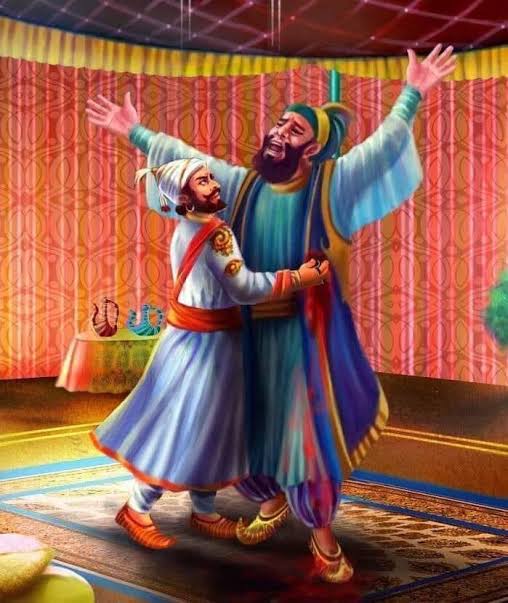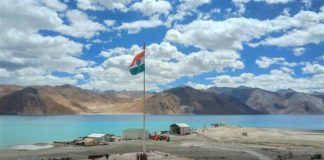Battle of Pratapgarh (10 November,1659)
The Battle of Pratapgarh (10 November,1659) was a battle fought at the fort of Pratapgarh near the town of Satara, Maharastra, India between the forces of the Marathas under the Maratha king Shivaji and the Adilshahi troops under the Adil Shahi general Afzal Khan. Marathas defeated the Adil Shahi forces. It led to the eventual establishment of the Maratha Empire and it was their first significant military victory against a major regional power.
Shivaji’s position was commendable in parts of Maval. The Adilshahi court wanted to barrage his activities. Afzal Khan was a renowned general of Bijapur who had previously killed Shivaji’s elder brother Sambhaji in a battle, was selected to lead an assault against Shivaji. He started from Bijapur. On 10 November, 1659 Chattrapati Shivaji Maharaj met Afzal Khan and killed him in a truce negotiation. Chattrapati Shivaji Maharaj forces then routed the scattered Adilshahi army.
Combat
Shivaji sent an emissary to Afzal Khan where he stated that he did not want to fight and was ready for peace. A meeting was arranged between Shivaji and Afzal Khan at a Shamiyana at the foothills of Pratapgarh. It was accordant that they would bring only ten personal bodyguards each with them. All the bodyguard would have to remain ‘one arrow-shot’ away from the pair. Chattrapati Shivaji Maharaj chose Sambhaji Kondhalpur, Jiva Mahala, Siddi Ibrahim, Kataji Ingle, Kondaji Kank, Yesaji Kank, Krishnaji Gaikwad, Surji Katak, Visaji Murambak and Sambhaji Karvar for the meet. Afzal Khan hide a Katyar in his coat and Shivaji wore armour underneath his clothes and carried a concealed wagh nakha in one hand.
When the two men entered the tent, Afzal Khan embraced Shivaji. Afzal Khan was 6’7” tall. He tried to strangle Shivaji in his vice-like grip and pierced his dagger in Shivaji. But the armour under Chattrapati Shivaji Maharaja’s clothes saved him. Shivaji retaliated his “wagh nakh” to slash Afzal Khan’s stomach and disemboweled Khan. Thereupon Afzal Khan’s bodyguard Bada Sayyed attacked Shivaji with a sword but Jiva Mahala, Shivaji’s personal bodyguard, fatally struck him down. Also (Krishna Bhaskar Kulkarni) a lawyer of Afzal Khan attacked Shivaji. Chattrapati Shivaji Maharaj killed Krishna Kulkarni with his sword. Khan managed to hold his gushing entrails and hurtled, fainting and bleeding outside the tent and threw himself into the palanquin. The bearers began moving rapidly away down the slope. Sambhaji Kavji Kondhalkar, Shivaji’s lieutenant and one of the accompanying guards, gave chase and beheaded Afzal Khan. The severed head was later sent to Rajgad to be shown to Jijabai (Shivaji’s mother). She had long wanted vengeance for the deliberate maltreatment of Shivaji’s father (Shahaji Bhosle) while a captive of Afzal Khan, and for his role in the death of her elder son (Sambhaji Sahaji Raje Bhosle). Shivaji sped up the escutcheon towards the fortress and his lieutenants ordered cannons to be fired. It was a signal to his infantry which was hidden in the densely forested valley to raid the Adilshahi forces.
Aftermath of the battle – Adilshahi forces lost their 65 elephants, 4000 horses, artillery, 1200 camels, jewels worth 300,000 Rupees, 1,000,000 Rupees, heaps of precious clothes, tents to the Marathas. They also lost their grain stored at Wai and money.
Around 5000 Adilshahi soldiers were killed and almost many were wounded. 3000 soldiers were arrested, and the rest were allowed to go home in defeat. The Marathas lost around 1,734 soldiers, while around 420 soldiers were wonded.
As it was the policy of Chattrapati Shivaji Maharaj to humanely treat the defeated army, no women were sold as slaves or molested. Injured commanders were offered treatment deserving of their rank and either sent back to Bijapur or arrested. Some of the injured Adilshahi generals like Siddi Hilal changed their loyalties and joined the Marathas to serve under Chattrapati Shivaji Maharaj. Chattrapati Shivaji Maharaj buried Afzal Khan as per Islamic customs and built his tomb near Pratapgarh, as per his philosophy of ‘once the enemy is dead, the enmity is dead too’.
Kanhoji Jedhe was presented with sword of honour for his invaluable and outstanding performance of service to Shivaji. Later the relatives of the killed soldiers were offered service in the Maratha army.
Afzal Khan’s death dealt the Adilshah’s rule a severe blow. A quarter of his forts, territory and a fifth of his army were arrested or destroyed, while Shivaji Maharaj doubled his territory, losing a tenth of his army, within fifteen days of Battle of Pratapgarh. Shivaji sending cavalry towards Kolhapur, which succeeded in capturing seventeen forts, including the prestigious fort of Panhala. Cavalry was sent towards Dabhol and Rajapur under the command of Doroji Patil, which was successful in capturing forts in southern Konkan.
This remarkable victory made Chattrapati Shivaji Maharaj a hero of Maratha folklore and a legendary figure among his people. Having successfully beaten back a major attack by a powerful empire and established military dominance, Shivaji had founded the nucleus of what would become the Maratha Empire.











I was just chatting with my coworker about this today at Outback steak house. Don’t remember how in the world we landed on the topic in reality, they brought it up. I do recall eating a exceptional fruit salad with cranberries on it. I digress